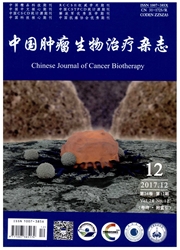

 中文摘要:
中文摘要:
目的:探讨复制缺陷型腺病毒载体(Ad)介导人血管内皮细胞生长因子受体-2(hVEGFR-2或hKDR)胞外段诱导抗小鼠肝癌血管免疫及打破免疫耐受的效果。方法:构建Ad hKDRE,用Ad hKDRE皮内免疫C57BL/6小鼠,7d后取脾细胞作为效应细胞(E),Hepa1-6/mKDR作为靶细胞(T),行乳酸脱氢酶(LDH)释放实验检测特异性CTL杀伤活性;给免疫小鼠接种肝癌细胞Hepa1-6,观察荷瘤小鼠成活情况。结果:Ad hKDRE免疫小鼠1周后,在E∶T为100∶1、50∶1和25∶1时,Ad hKDRE诱导的6hCTL杀伤率分别为(81.5±5.6)%、(68.4±5.5)%和(39.6±3.9)%。Ad hKDRE免疫小鼠1周后接种2×10^6 Hepa1-6肝癌细胞,观察2个月无小鼠成瘤;接种5×106 Hepa1-6细胞,小鼠无瘤成活率为60%。上述CTL效应和抗成瘤作用在清除CD8+和CD4+ T淋巴细胞后消失。结论:Ad介导异种(人)KDR胞外段能有效地打破小鼠肝癌的免疫耐受,诱发强烈的抗原特异性细胞免疫反应,这种特异性细胞免疫反应是CD4^+和CD8^+ T细胞依赖性的。
 英文摘要:
英文摘要:
Objective: To investigate the role of replication-defective adenovirus vector encodinG human extracellular domain of vascular endothelial growth factor receptor-2 ( hVEGFR-2 or hKDR) in induction of immunity against murine hepatocellular carcinomas and in breaking the immune tolerance. Methods: Ad hKDRE were constructed and were used to immunize C57BL/6 mice. Seven days after immunization mice splenocytes were collected as effectors and Hepa 1-6/mKDR cells were used as target cells for lactate dehydrogenase (LDH) release assay to analyze the cytotoxic ac- tivity of antigen-specific cytotoxic T lymphocytes (CTL). In addition, immunized mice were transplanted with Hepa 1-6 cells and the survival of tumor-bearing mice was observed. Results: Seven days after the immunization, 6 h cytotoxic activity of CTL elicited by the Ad hKDRE were (81.5 ±5.6) % , (68.4 ± 5.5) % , and (39.6 ±3.9) % at the ratio of effector: target (E: T) of 100: 1,50: 1, and 25: 1, respectively. In addition, no tumor formed 2 months after implantation of 2 × 10^6hepatoma cells in Ad hKDRv-immunized mice ; after implantation of 5 × 10^6 hepatoma cells, 60% of the mice survived without bearing tumor. The above CTL activity and protection against tumor disappeared when CD8^+ and CD4^+ T lymphocytes were depleted from mice. Conclusion: Adenovirus vector-medlated xenogeneic extracellular domain of KDR can effectively break the immune tolerance to murine hepatocellular carcinomas in mice and induce a strong antigen- specific T cell response, which is dependent on CD8^+ and CD4^+ T cells.
 同期刊论文项目
同期刊论文项目
 同项目期刊论文
同项目期刊论文
 期刊信息
期刊信息
